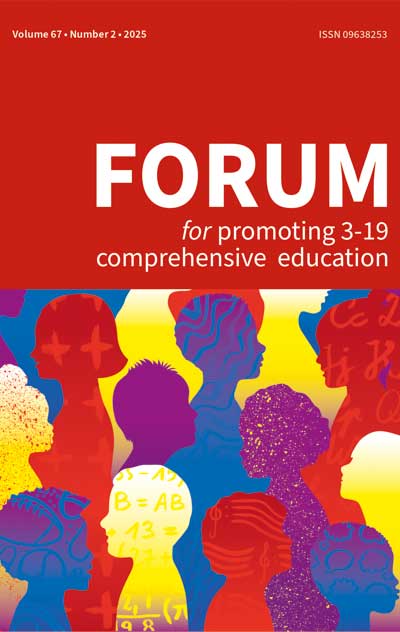
Joining the dots: part 2. SEND and AP: creating a second schooling system
FORUM - Print ISSN 1474-7685 - Online ISSN 2047-7171
Volume 67 Number 2 (2025)
Joining the dots: part 2. SEND and AP: creating a second schooling system
Craig Johnston, Sally Tomlinson pages 41‑52
DOI: 10.3898/forum.2025.67.2.04
Abstract
In the first part of this article published in FORUM 66, 1 (2024), we noted that the English mass state education system, developing over 150 years, had created subsystems for (predominantly disadvantaged) children and/or young people who would not or could not function in mainstream schools.1 This followed the development of mass elementary schooling in the 1870s. It seemed then, as it often does now, that many teachers in mainstream schools – working in the six-standard age-related classes – increasingly struggled with the business of equipping children and/or young people to pass required tests while so called ‘disruptive, disabled or defective children’ were present. The expansion and associated costs of alternative (education) provisions (APs) for those labelled as having special needs or disabilities (SEND) – either in separate spaces, and/or offsite settings such as pupil referral units (PRUs) – always worried government and local authorities. At different points, and by different government agencies, concerns were raised about the quality of these provisions – especially applied to the extra funding given for those pupils of school age in APs.2 By 2022 the Conservative government, apparently appalled at the debt local authorities were accumulating to deal with expanding numbers of children and young people in these educational subsystems, decided to join SEND, PRUs and a growing array of APs together for planning and funding purposes, and to address official and unregulated forms of schooling.3 This second article examines, in more detail, how these subsystems have developed, the laments from politicians and the media that ‘the SEND system is broken’, especially through debt, and whether and how the efforts to link SEND and seemingly endless forms of AP more closely are working (or intended to work) under a recently elected Labour government. It concludes that although current policy suggests that there will be more ‘inclusion’ of children and young people regarded as concerns or disadvantaged by the education system, the organisation, funding and curriculum in separate spaces may mean that SEND and AP are a separate schooling system and will continue to be treated as such.
SORRY - you are not registered as being permitted online access to the full text of this article
You have the following options:
- If you are viewing this via an institution or academic library you can ask that your institution takes out a Subscription to this journal.
- If you already have a Personal Subscription please login below
Forgotten your username / password? Click here to locate
- Purchase an annual Personal Subscription
PRINT + DIGITAL personal subscription (£45 / year)
DIGITAL personal subscription (£35 / year)
A Personal Subscription provides immediate access not only to the single article you are seeking, but also to all past and future articles in this journal up to the expiry of your annual (calendar year) subscription. - Purchase immediate access to this single article (UK£7.00) - Buy article Coming Soon
To cite this article
Craig Johnston, Sally Tomlinson (2025) Joining the dots: part 2. SEND and AP: creating a second schooling system, FORUM, 67(2), 41-52 . https://doi.org/10.3898/forum.2025.67.2.04
